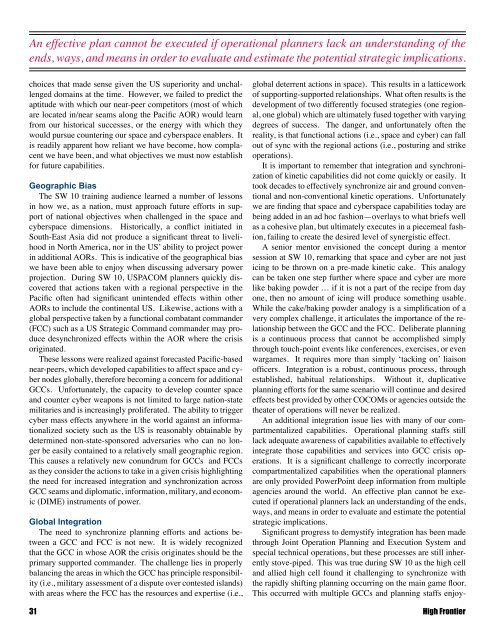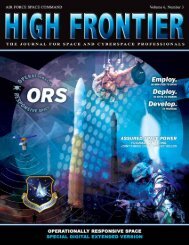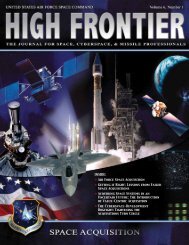Schriever Wargame 2010 - Air Force Space Command
Schriever Wargame 2010 - Air Force Space Command
Schriever Wargame 2010 - Air Force Space Command
- No tags were found...
Create successful ePaper yourself
Turn your PDF publications into a flip-book with our unique Google optimized e-Paper software.
An effective plan cannot be executed if operational planners lack an understanding of the<br />
ends, ways, and means in order to evaluate and estimate the potential strategic implications.<br />
choices that made sense given the US superiority and unchallenged<br />
domains at the time. However, we failed to predict the<br />
aptitude with which our near-peer competitors (most of which<br />
are located in/near seams along the Pacific AOR) would learn<br />
from our historical successes, or the energy with which they<br />
would pursue countering our space and cyberspace enablers. It<br />
is readily apparent how reliant we have become, how complacent<br />
we have been, and what objectives we must now establish<br />
for future capabilities.<br />
Geographic Bias<br />
The SW 10 training audience learned a number of lessons<br />
in how we, as a nation, must approach future efforts in support<br />
of national objectives when challenged in the space and<br />
cyberspace dimensions. Historically, a conflict initiated in<br />
South-East Asia did not produce a significant threat to livelihood<br />
in North America, nor in the US’ ability to project power<br />
in additional AORs. This is indicative of the geographical bias<br />
we have been able to enjoy when discussing adversary power<br />
projection. During SW 10, USPACOM planners quickly discovered<br />
that actions taken with a regional perspective in the<br />
Pacific often had significant unintended effects within other<br />
AORs to include the continental US. Likewise, actions with a<br />
global perspective taken by a functional combatant commander<br />
(FCC) such as a US Strategic <strong>Command</strong> commander may produce<br />
desynchronized effects within the AOR where the crisis<br />
originated.<br />
These lessons were realized against forecasted Pacific-based<br />
near-peers, which developed capabilities to affect space and cyber<br />
nodes globally, therefore becoming a concern for additional<br />
GCCs. Unfortunately, the capacity to develop counter space<br />
and counter cyber weapons is not limited to large nation-state<br />
militaries and is increasingly proliferated. The ability to trigger<br />
cyber mass effects anywhere in the world against an informationalized<br />
society such as the US is reasonably obtainable by<br />
determined non-state-sponsored adversaries who can no longer<br />
be easily contained to a relatively small geographic region.<br />
This causes a relatively new conundrum for GCCs and FCCs<br />
as they consider the actions to take in a given crisis highlighting<br />
the need for increased integration and synchronization across<br />
GCC seams and diplomatic, information, military, and economic<br />
(DIME) instruments of power.<br />
Global Integration<br />
The need to synchronize planning efforts and actions between<br />
a GCC and FCC is not new. It is widely recognized<br />
that the GCC in whose AOR the crisis originates should be the<br />
primary supported commander. The challenge lies in properly<br />
balancing the areas in which the GCC has principle responsibility<br />
(i.e., military assessment of a dispute over contested islands)<br />
with areas where the FCC has the resources and expertise (i.e.,<br />
global deterrent actions in space). This results in a latticework<br />
of supporting-supported relationships. What often results is the<br />
development of two differently focused strategies (one regional,<br />
one global) which are ultimately fused together with varying<br />
degrees of success. The danger, and unfortunately often the<br />
reality, is that functional actions (i.e., space and cyber) can fall<br />
out of sync with the regional actions (i.e., posturing and strike<br />
operations).<br />
It is important to remember that integration and synchronization<br />
of kinetic capabilities did not come quickly or easily. It<br />
took decades to effectively synchronize air and ground conventional<br />
and non-conventional kinetic operations. Unfortunately<br />
we are finding that space and cyberspace capabilities today are<br />
being added in an ad hoc fashion—overlays to what briefs well<br />
as a cohesive plan, but ultimately executes in a piecemeal fashion,<br />
failing to create the desired level of synergistic effect.<br />
A senior mentor envisioned the concept during a mentor<br />
session at SW 10, remarking that space and cyber are not just<br />
icing to be thrown on a pre-made kinetic cake. This analogy<br />
can be taken one step further where space and cyber are more<br />
like baking powder … if it is not a part of the recipe from day<br />
one, then no amount of icing will produce something usable.<br />
While the cake/baking powder analogy is a simplification of a<br />
very complex challenge, it articulates the importance of the relationship<br />
between the GCC and the FCC. Deliberate planning<br />
is a continuous process that cannot be accomplished simply<br />
through touch-point events like conferences, exercises, or even<br />
wargames. It requires more than simply ‘tacking on’ liaison<br />
officers. Integration is a robust, continuous process, through<br />
established, habitual relationships. Without it, duplicative<br />
planning efforts for the same scenario will continue and desired<br />
effects best provided by other COCOMs or agencies outside the<br />
theater of operations will never be realized.<br />
An additional integration issue lies with many of our compartmentalized<br />
capabilities. Operational planning staffs still<br />
lack adequate awareness of capabilities available to effectively<br />
integrate those capabilities and services into GCC crisis operations.<br />
It is a significant challenge to correctly incorporate<br />
compartmentalized capabilities when the operational planners<br />
are only provided PowerPoint deep information from multiple<br />
agencies around the world. An effective plan cannot be executed<br />
if operational planners lack an understanding of the ends,<br />
ways, and means in order to evaluate and estimate the potential<br />
strategic implications.<br />
Significant progress to demystify integration has been made<br />
through Joint Operation Planning and Execution System and<br />
special technical operations, but these processes are still inherently<br />
stove-piped. This was true during SW 10 as the high cell<br />
and allied high cell found it challenging to synchronize with<br />
the rapidly shifting planning occurring on the main game floor.<br />
This occurred with multiple GCCs and planning staffs enjoy-<br />
31 High Frontier











